





When I Feel Like Interrupting – Social Story for Self-Control
₹80
₹160
50% off
0 (0 ratings)
Grade Levels
Pre-K - Grade 3 (Ages 4-9)
Content Overview
Format: Printable PDF, Total Pages: 11, Features: 16 real-life segments, engaging illustrations, 6 interactive activities.
Categories
Pages from the Resource
Help children learn self-control and turn-taking with this engaging social story on interrupting. Designed for young learners, it uses real-life scenarios, first-person storytelling, and interactive activities to teach patience, listening skills, and respectful communication. Great for kids with ADHD, autism, and social-emotional challenges.

Page 1

Page 2
What Users Say
0
0 ratings
5
0+
4
0+
3
0+
2
0+
1
0+
5 Stars
Product is Good to use.
9 months ago
Varsha Parent
Similar Products
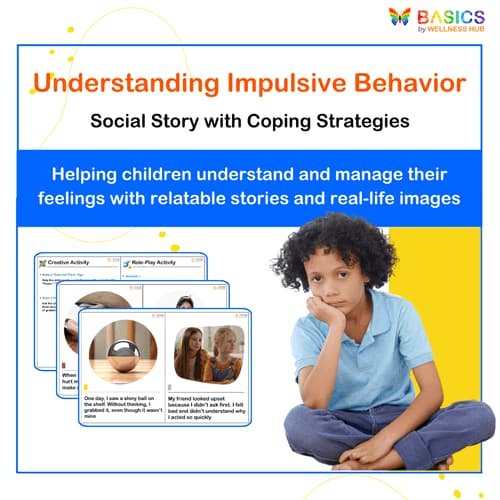
Understanding Impulsive Behavior: Social Story with Coping Strategies
₹ 80.00
₹ 160.00
50% off
4.9 (42 ratings)
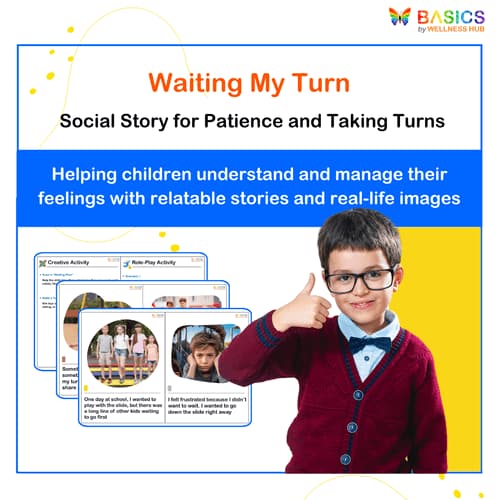
Waiting My Turn – Social Story for Patience and Taking Turns
₹ 80.00
₹ 160.00
50% off
4.7 (56 ratings)
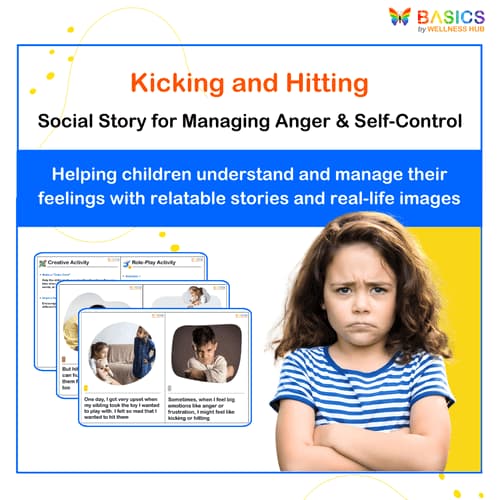
Kicking and Hitting – Social Story for Managing Anger & Self-Control
₹ 80.00
₹ 160.00
50% off
4.6 (52 ratings)
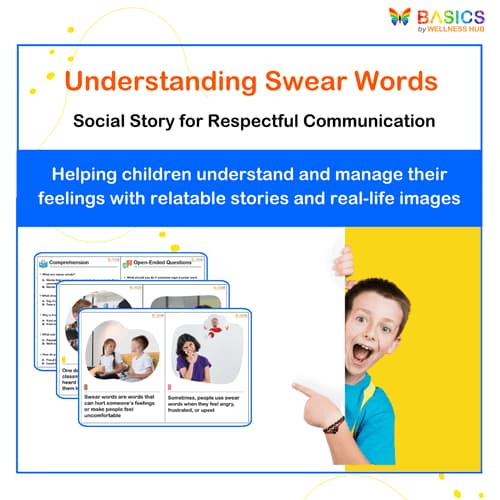
Understanding Swear Words – Social Story for Respectful Communication
₹ 80.00
₹ 160.00
50% off
4.9 (48 ratings)
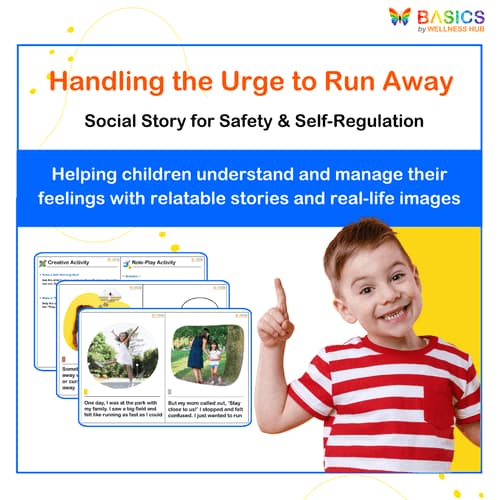
Handling the Urge to Run Away – Social Story for Safety & Self-Regulation
₹ 80.00
₹ 160.00
50% off
4.8 (44 ratings)
About the Product
Learning to wait for our turn to speak is an essential social skill that helps children develop patience, respect, and effective communication. Many children, especially those with impulsivity challenges, struggle with interrupting conversations. This social story provides a structured and engaging way to teach children about the importance of waiting their turn, listening actively, and respecting others when they speak.
"When I Feel Like Interrupting" is a first-person social story designed to help young learners understand why interruptions can be disruptive and how they can manage their impulse to speak at the right time. This resource is especially useful for children with autism, ADHD, or other special needs, as well as for any young learner developing communication and self-regulation skills.
Product Details
- Format: Printable PDF
- Total Pages: 11
- Content:
- Social Story: 16 short segments, each featuring real-life images and simple, relatable text.
- Follow-Up Activities: 6 interactive exercises reinforcing key learning points.
- Features:
- First-person perspective storytelling
- Clear, real-life imagery for better comprehension
6 structured activities: Vocabulary, Spelling, Comprehension, Open-ended Questions, Creative Expression, and Role-Playing
Educational Benefits
✔ Develops Social Awareness – Teaches children to recognize when they are interrupting and why waiting for their turn is important.
✔ Supports Emotional Regulation – Encourages self-control and managing impulses in conversations.
✔ Enhances Communication Skills – Helps children learn the importance of active listening and speaking at the right time.
✔ Encourages Self-Reflection – Through open-ended questions and activities, children can think about their behavior and ways to improve it.
✔ Beneficial for Children with Autism & ADHD – Supports children who struggle with waiting and turn-taking in conversations, making social interactions smoother.
✔ Great for Classrooms & Home Learning – A useful tool for teachers, therapists, and parents working on social skills and behavior management.
Instructions for Use
- Read the Social Story Together
- Sit with the child and read the story aloud, emphasizing the key points.
- Discuss the pictures to help the child connect with real-life situations.
- Pause and Ask Questions
- Throughout the story, ask the child to reflect:
- "How would you feel if someone interrupted you?"
- "What can we do instead of interrupting?"
- Engage with Follow-Up Activities
- Vocabulary & Spelling Practice: Reinforce words related to patience, waiting, and conversations.
- Comprehension Questions: Help children recall and apply what they’ve learned.
- Open-Ended Questions: Allow children to share their own experiences with interrupting.
- Creative Expression: Activities such as drawing or writing about a time they waited patiently.
- Role-Playing: Act out different social scenarios where interrupting is a challenge and practice using self-control strategies.
- Reinforce Concepts Daily
- Use real-life examples to remind children about waiting their turn.
- Praise children when they successfully wait for their turn to speak.
Activities Using the Resource
- Vocabulary Activity:
- Objective: To reinforce understanding of key vocabulary related to patience and turn-taking.
- Instructions: Provide a list of 5 vocabulary words from the story, such as interrupt, wait, listen, turn, and patience. For each word, provide two options for definitions.
- Example:
- Word: Interrupt
- To speak or act before someone finishes.
- To quietly listen without speaking.
- Answer: To speak or act before someone finishes.
- Word: Interrupt
- Benefit: Helps children develop vocabulary and understanding of concepts associated with good communication skills.
- Spelling Activity:
- Objective: To improve spelling and word recognition skills.
- Instructions: Present 8 pairs of words from the vocabulary list, with one word spelled correctly and the other misspelled. The child needs to identify the correct spelling.
- Example:
- Interrupt / Interupt
- Listen / Lissten
- Benefit: Reinforces word recognition and spelling accuracy while connecting to the social story's theme.
- Comprehension Activity:
- Objective: To test the child's understanding of the social story and its concepts.
- Instructions: After reading the story, ask 5 multiple-choice questions based on the content. For example:
- Question: What happens when I interrupt someone?
- The conversation continues smoothly.
- The conversation gets disrupted.
- Answer: The conversation gets disrupted.
- Question: What happens when I interrupt someone?
- Benefit: Strengthens the child's understanding of the story’s main ideas, focusing on the impact of interrupting and the benefits of waiting.
- Open-Ended Questions:
- Objective: To encourage self-reflection and problem-solving.
- Instructions: Ask the child open-ended questions to help them process the information and connect it to their own experiences.
- Example Questions:
- Can you think of a time when you interrupted someone?
- What can you do instead of interrupting?
- Benefit: Promotes emotional regulation and helps children express their feelings.
- Creative Activity:
- Objective: To help children express themselves through art or writing.
- Instructions: Ask the child to draw what they feel when they want to interrupt or write a short story about a time they waited their turn to speak.
- Benefit: Encourages emotional expression and reinforces the concepts of patience and self-regulation.
- Role-Playing Activity:
- Objective: To practice real-life scenarios involving interruptions and turn-taking.
- Instructions: Set up a role-play where the child practices waiting their turn in a conversation, either with you or a peer. Use phrases like “It’s okay to feel excited, but now it’s my turn to talk!”
- Benefit: Teaches and reinforces positive behavior in social settings, helping the child practice self-control in a safe, supportive environment.
FAQs
Q1. What age group is this social story intended for?
This social story is designed for young children, typically ages 4-7, but can be adapted for older children who need support with impulse control and communication.
Q2. How do I use this social story at home or in a classroom setting?
You can use this resource by reading it with the child, discussing each segment, and then engaging them in the follow-up activities. It is ideal for daily practice and reinforcement in a relaxed, interactive setting.
Q3. Can this social story help children with autism or ADHD?
Yes, this resource is particularly helpful for children with autism, ADHD, or other developmental disorders. The story provides a structured and visual approach to understanding turn-taking and impulse control, which are key challenges for many children with these conditions.
Q4. How often should I use this resource with my child?
It’s beneficial to review the social story regularly, especially during moments when the child is struggling with impulsivity or communication. The activities can be revisited as needed to reinforce the concepts.
Q5. Are there additional resources available for teaching social skills?
Yes, we offer a variety of social stories and resources designed to teach various social skills, emotional regulation, and behavior management. These resources can be found on our website and are perfect for building a comprehensive toolkit for helping children navigate social situations.
Q6. Can I customize the activities in this resource?
Absolutely! The activities can be modified to fit the child’s developmental level or specific needs. For example, you can adjust the complexity of the vocabulary activity or create additional scenarios for the role-play to better suit the child’s learning pace.
Usage Rights and Restrictions
- Personal Use Only: This resource is for personal use only. You may print and use it with your child or in your classroom, but it may not be reproduced, sold, or shared for commercial purposes.
- Non-Transferable: The license is granted to the original purchaser and is non-transferable.
- Digital and Physical Use: You may print this social story for home or classroom use. Digital versions may not be shared or distributed outside of the licensed use.
Conclusion
"When I Feel Like Interrupting" is an essential social story designed to help children understand the importance of waiting their turn in conversations. By using engaging activities and real-life scenarios, this resource promotes emotional regulation, patience, and effective communication skills. Whether at home or in the classroom, this resource supports young learners in developing positive social behaviors.
Use this resource as part of your ongoing efforts to teach children about impulse control, empathy, and respectful communication. With regular use and reinforcement through the activities provided, children will be better equipped to manage their emotions and interact appropriately with others in social settings.



